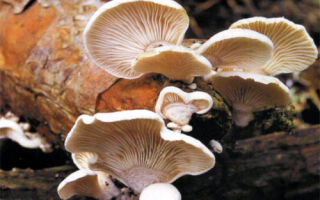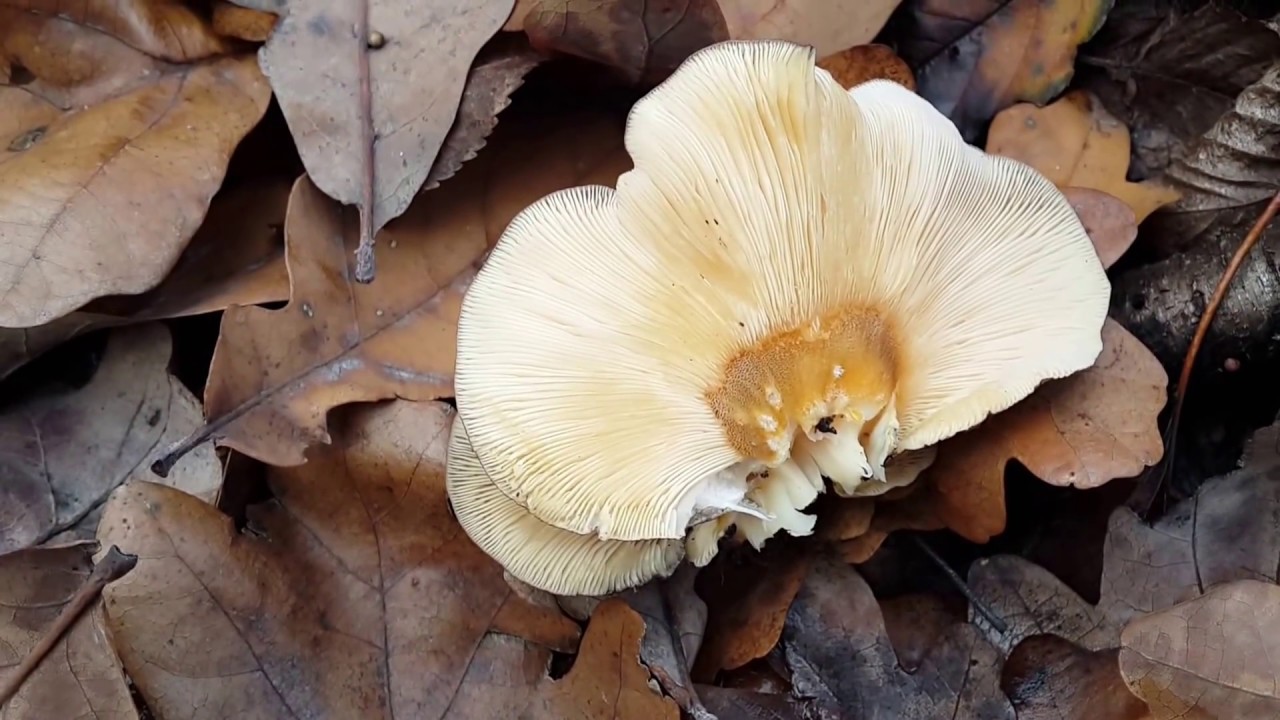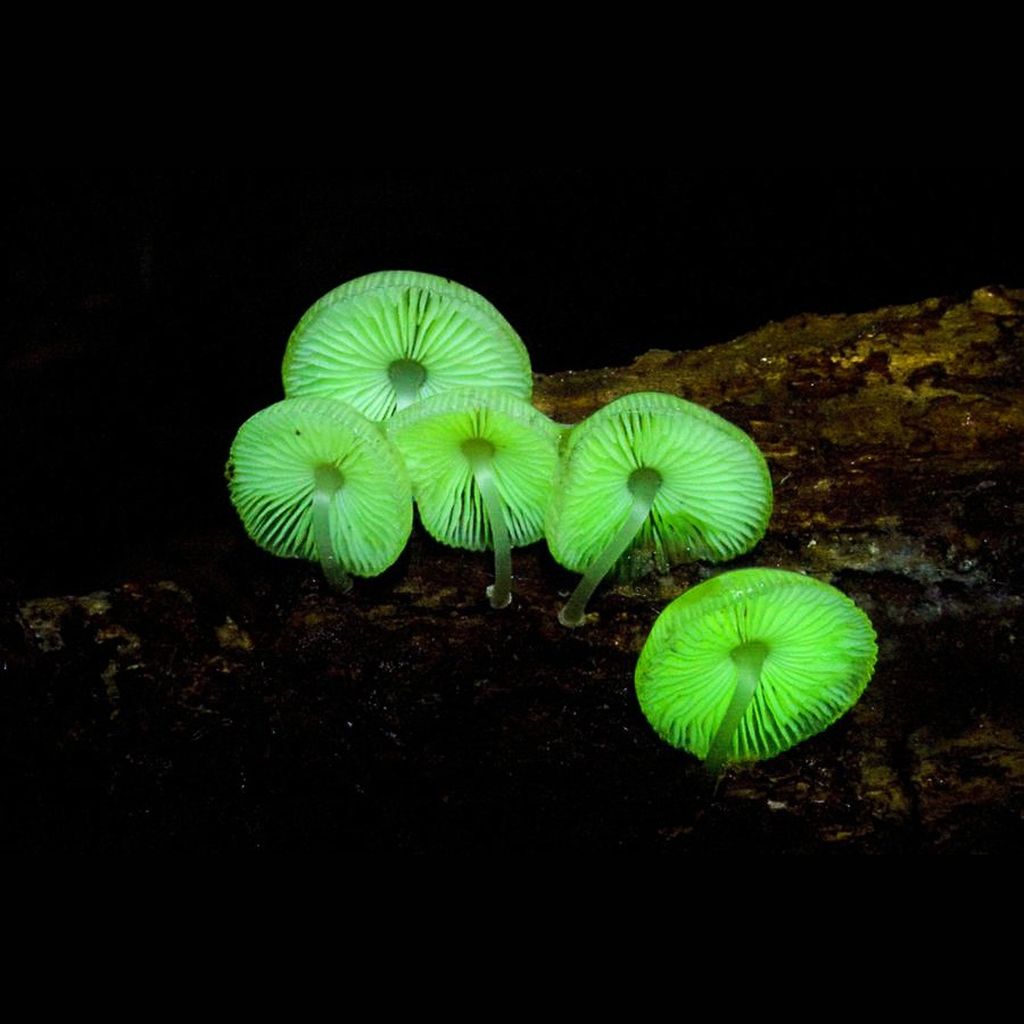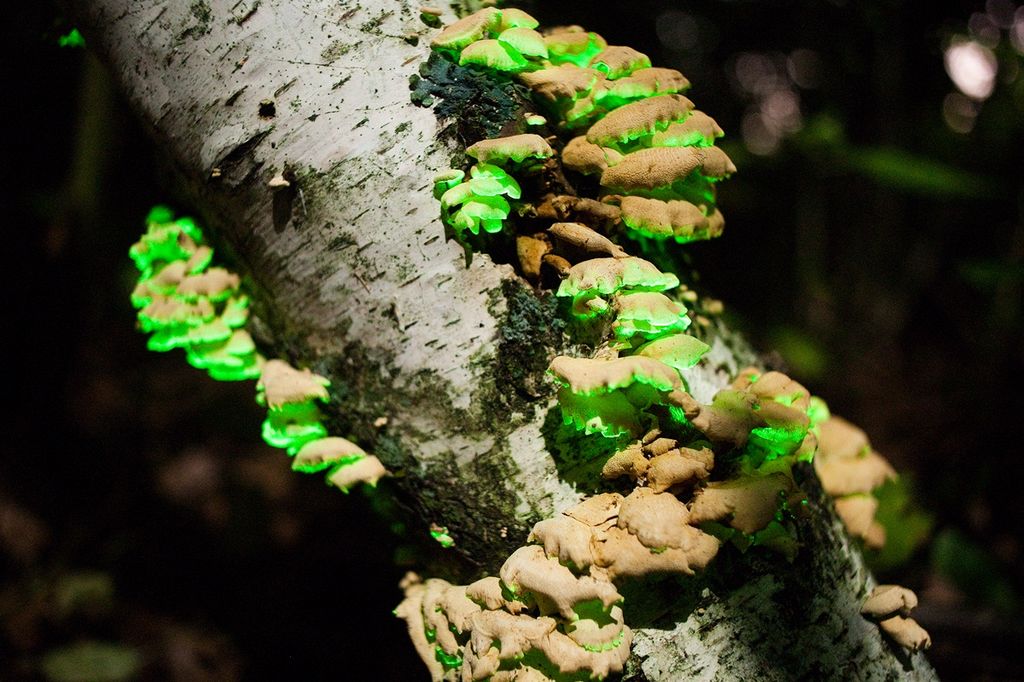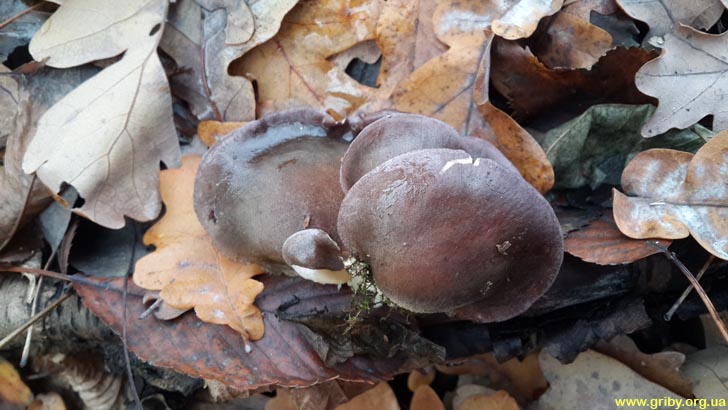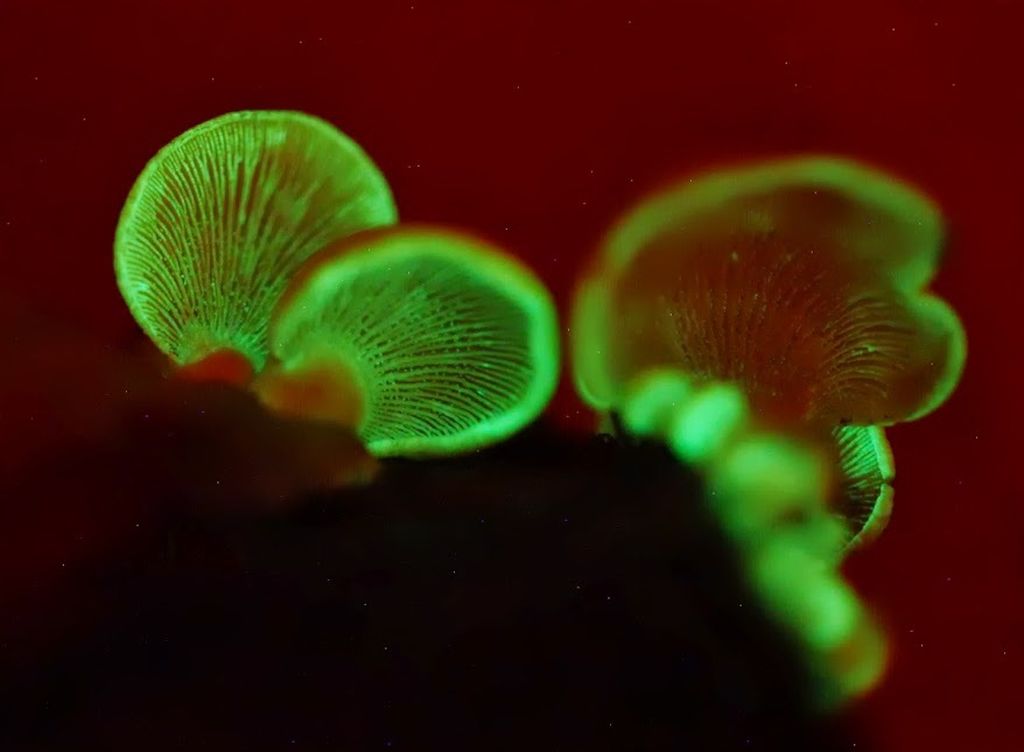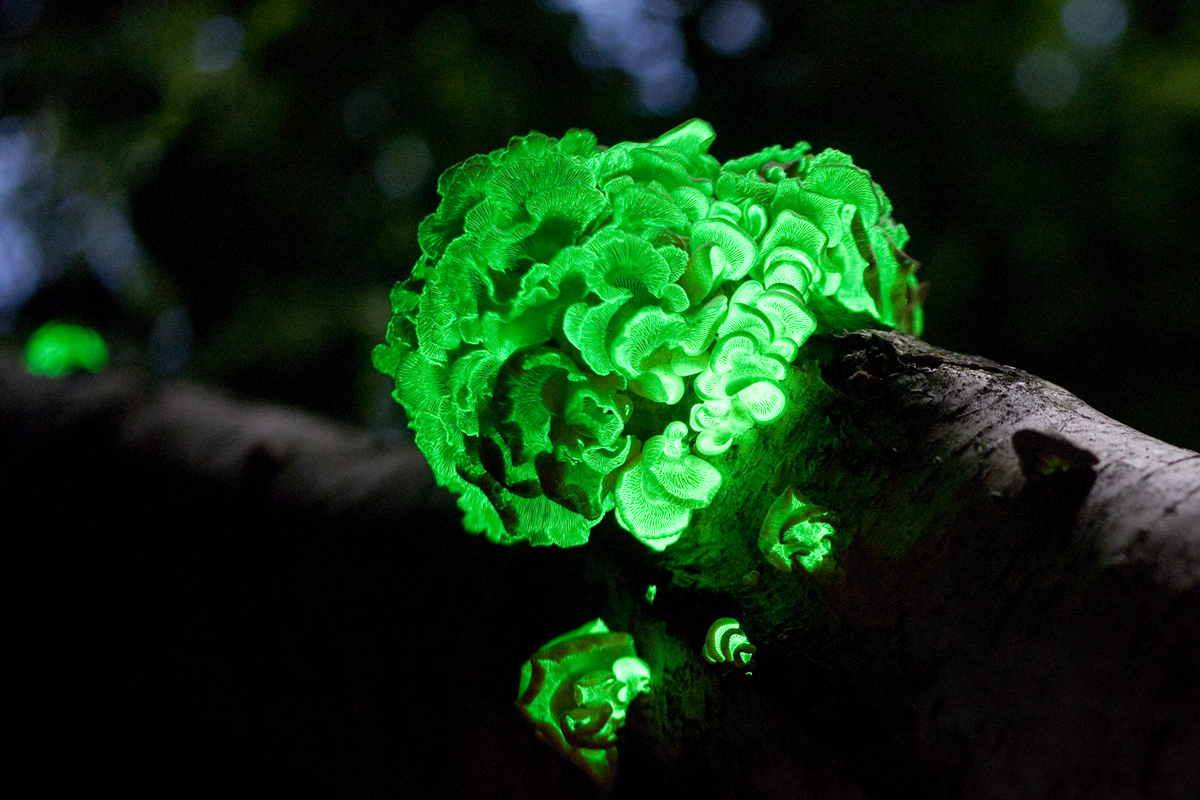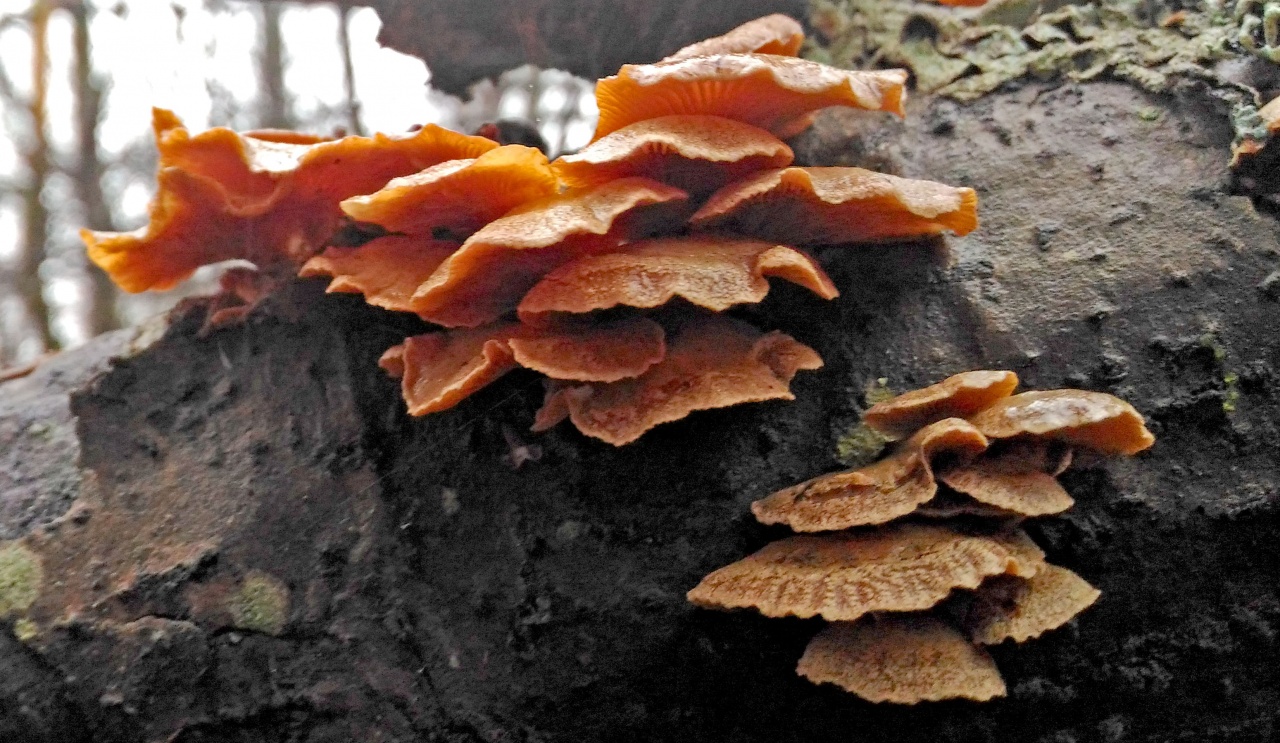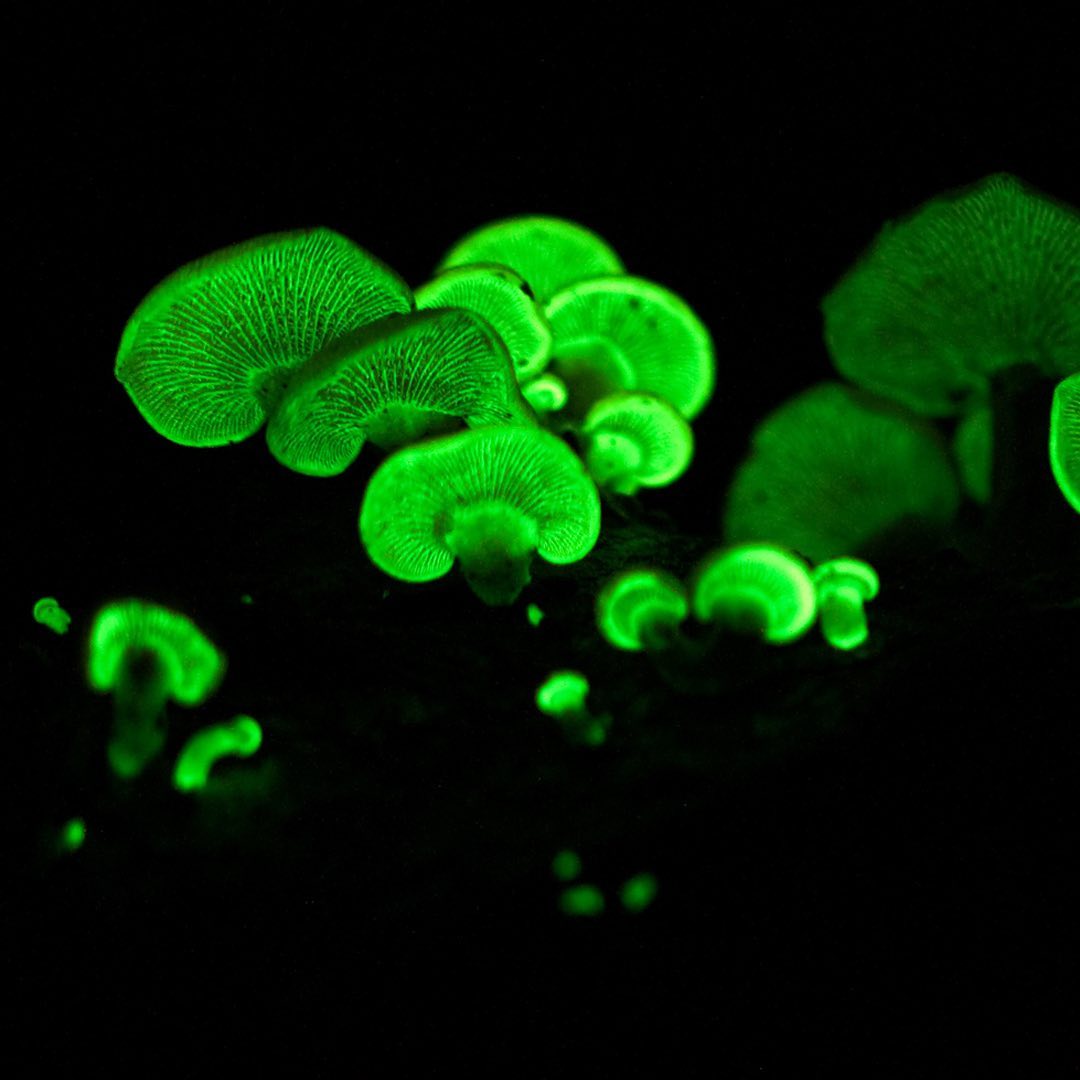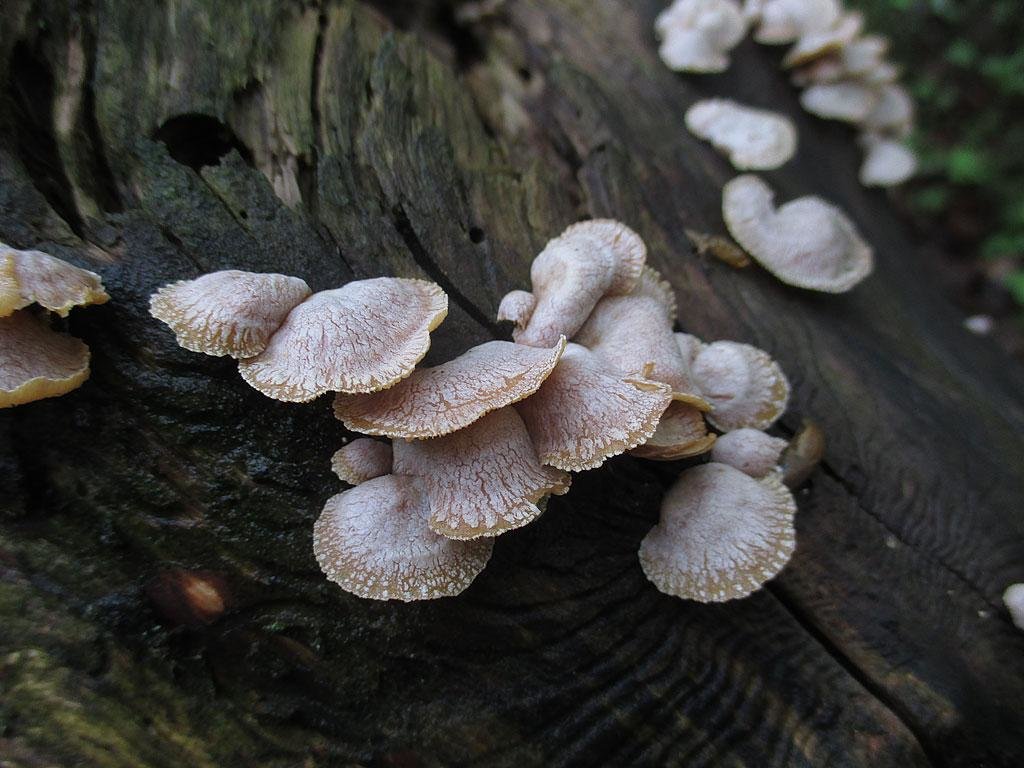Biological description
The cap is 1–32 mm in diameter, kidney-shaped, with a dry or wet, smooth or fleecy surface, painted in whitish, greenish, brownish or lilac tones. The hymenophore is lamellar, glowing in the dark in some species. Plates are frequent or rather rare, white, ocher, olive, brownish or lilac in color.
The leg is not present in all species; it is very short, eccentric, fleecy, of the same color as the cap.
The pulp is odorless, with a bland or pungent taste.
Spores 3-11 × 0.5-3.5 microns, sausage, oblong, elliptical or cylindrical, amyloid. Basidia are tetrasporous, clavate, non-amyloid, 11-28 × 2.5-6.3 µm. Cheilocystids are cylindrical, clavate, fusiform or irregular, thin-walled. Pleurocystids are not present in all species. Pileocystids are present in most species, thin or thick walled.
Description
Hat
At the beginning of growth, it has a kidney-shaped shape, then gradually takes the form of a fan, it can be ear-shaped, the center becomes depressed. The surface of an adult fungus is covered with small grains and numerous cracks. The surface is matte, the edge of the cap is wavy, ribbed. The color of the cap is brown, with an ocher or grayish tint, sometimes clay. The size of the cap reaches from 2 to 4 centimeters in diameter, rare specimens grow up to 5 cm.
hymenophore
Leg
Short, almost rudimentary, rarely exceeding 1 cm in length. The location is lateral, the shape is usually cylindrical, curved. The color matches the color of the cap. The structure is dense, fibrous, solid.
Pulp
Dense, elastic. The color is creamy or yellow-brown, has a faint mushroom aroma and an astringent to acrid taste. At the site of a break or cut, upon contact with air, it does not change color, milky sap does not emit.
Astringent panelus (Panellus stipticus)
Astringent Panellus (Panellus stipticus) is a bioluminescent fungus, a fairly common type of fungus, with an extensive habitat.
External description
The fruiting body of the binder panellus consists of a cap and a stem. The mushroom is characterized by leathery and thin flesh, which has a light or ocher color. She has an astringent taste, a little pungent.
The diameter of the mushroom cap is 2-3 (4) cm. Initially, its shape is reniform, but gradually, as the fruiting bodies mature, the cap becomes depressed, ear-shaped, fan-shaped, covered with grains and many small cracks. The surface of the cap is matte, and its edges are ribbed, wavy or lobed. In color, the cap of this mushroom can be pale ocher, light brown, ocher brown, or clayey.
The hymenophore of the binder panellus is represented by plates, which are characterized by a small thickness, grow to the surface of the fruiting body, are very narrow and are located at a short distance, reach almost downward along the stem of the fungus, have bridges, the same color as the cap (sometimes slightly darker than it). The color of the plates is often gray-ocher or light brown. Their edges are slightly lighter than the middle.
Season and habitat of the mushroom
It is possible to meet binder panel on a fairly large area. It grows in Asia, Europe, Australia, North America. The described species of mushrooms is found in the northern part of Russia, Siberia, the Caucasus, Primorsky Territory. But in the Leningrad region, this mushroom is practically not found.
Binder panel grows mainly in groups, on decaying stumps, logs, deciduous tree trunks. Especially often it grows on beeches, oaks and birches. The size of the described mushroom is very small and often these mushrooms completely cling to whole stumps.
Active fruiting of the astringent panelus begins in the first half of August. In some literary sources it is also written that the fruiting bodies of the described fungus begin to grow actively already in spring.Until late autumn, whole colonies of astringent panellus appear on deadwood of deciduous trees and old stumps, which often grow together at their bases. You can not meet them too often, and the drying of mushrooms of the described species occurs without involving the processes of decay. In the spring you can often see the dried fruit bodies of the astringent panellus on stumps and old tree trunks.
Similar types and differences from them
Panellus astringent is slightly similar in appearance to an inedible mushroom called soft (tender) panellus. True, the latter is distinguished by white or whitish fruiting bodies. Such mushrooms have a very mild taste, and they grow mainly on the fallen branches of coniferous trees (more often they ate).
Other information about the mushroom
The bioluminescent properties of the binder panel are due to a chemical reaction involving luceferin (a pigment that emits light) and oxygen. The interaction of these substances leads to the fact that the tissues of the fungus begin to glow greenish in the dark.
Oysteroid panel
Somewhat puzzling is the confusion in the Russian names of this mushroom: here there is oyster mushroom Panel, and Late Panellus, and Autumn Oyster, and even Winter Oyster, not to mention Late Oyster or Willow Pig ... And all these names more or less reflect the essence of the mushroom. However, mycologists have already ceased to consider this mushroom as oyster mushroom and isolated it as a separate genus.
Description of the mushroom Panellus oysteroid
At first glance, an inexperienced amateur mushroom picker, oyster mushroom panel can be mistaken for oyster oyster mushroom. The oyster mushroom panellus grows at about the same time and on the same trees as the oyster mushroom (late autumn, winter; dead mossy fallen trees of deciduous species). But if you take a closer look, you will notice that the cap of the Panellus is not as smooth as that of the oyster mushroom, but slightly velvety, and even with some specks.
And the leg of this mushroom, in contrast to the oyster mushroom, has a fairly clearly marked border with the cap. It should be noted right away that the color of the cap of the oyster mushroom panellus is quite varied, of a gray-brown range, and the leg is short, slightly fleecy, of yellow-brown shades.
For me personally, the oyster mushroom panel, in such a form that it can be uniquely identified as a pannelus, has come across so far only once - after a week of rains on November 19, 2015, in some places along the Prilutsk area. At the same time and in the same forest, a fair amount of winter honey fungus and Judas' ear was seen, as well as a large bush of old scaly scales.
Oyster mushroom panel on video
Oyster mushroom panel can be eaten, but mushrooms should be selected at a young age, since the older ones become tough and inedible for this reason. It is recommended to boil the oyster mushroom panel for about five minutes, and then stew it with onions.
Join our new group lovers of quiet hunting
Late oyster mushroom, Panellus serotinus
Hat: "Oysteroid" (lateral, ear-shaped or lingual), 3-8 cm in diameter. The surface is slightly velvety, shiny and smooth in wet weather, the edges are tucked up, slightly fleecy in young specimens. The color is very diverse - it depends on the age of the fungus, growing conditions, and moisture regime. Color - from dark olive, brownish to blue-green; with age, it can fade to beige and dirty yellow. The flesh of the cap is thick, whitish, with characteristic “gelatinous” layers that prevent freezing. The smell is pleasant, the taste is slightly bitter or astringent.
Hymenophore: Plates are frequent, adherent, yellowish or light ocher, darken to brownish with age.
Spore powder: White.
Leg: Lateral, rudimentary, ocher-yellow, strikingly contrasting with light plates.
Spreading: Late oyster mushroom (late panelus), as the name implies, bears fruit from mid-September to late autumn, holding out after the first frosts; grows on stumps and deadwood of deciduous trees, preferring a well-rotted, mossy substrate. Occurs in large groups.
Similar species: The peculiar color, late fruiting and gelatinous flesh make it possible to distinguish Panellus serotinus with complete confidence from other "oyster mushrooms".
Edibility: Late panelus is considered an edible mushroom, but of little value. The gelatinous layers in the hats do not stimulate the appetite.
Author's notes: For some people, a green late pawn is an ordinary mushroom, one of those on whom it is a pity to spend a flash, but he pleasantly surprised me: it is not at all clear from the books that the late panellus is so large, elegant and green. Having picked up a few sticks of fresh panelellus for the first time, I brought them home and remained in a festive mood for a long time, I myself do not know why.
The ratio of the plates to the stem is perhaps the most characteristic (and, more importantly, unchanging) feature of the late panelus: if you look closely, you can even see such a border separating one from the other. And so, of course, pure oyster mushroom
Looking at the panelluses sadly hanging from a birch trunk, one inevitably wonders: what will come to replace autumn? Winter? And then what? And will there be anything at all? Or - everything will last like this, and last, and last until the day merges with the night, and the light - with the shadow, and everything will become exactly gray, dim, homogeneous. Such questions are posed to a person by these gloomy gray-green mushrooms.
The hat isn't all that smooth if you look closely. When wet, Panellus serotinus looks much more respectable - it seems, especially if against the background of moss, that solid fleshy caps have sprouted themselves with moss.
Panelus binder
Astringent panelus (Panellus stipticus)
Astringent Panellus (Panellus stipticus) is a bioluminescent fungus, a fairly common type of fungus, with an extensive habitat.
External description
The fruiting body of the binder panellus consists of a cap and a stem. The mushroom is characterized by leathery and thin flesh, which has a light or ocher color. She has an astringent taste, a little pungent.
The diameter of the mushroom cap is 2-3 (4) cm. Initially, its shape is reniform, but gradually, as the fruiting bodies mature, the cap becomes depressed, ear-shaped, fan-shaped, covered with grains and many small cracks. The surface of the cap is matte, and its edges are ribbed, wavy or lobed. In color, the cap of this mushroom can be pale ocher, light brown, ocher brown, or clayey.
The hymenophore of the binder panellus is represented by plates, which are characterized by a small thickness, grow to the surface of the fruiting body, are very narrow and are located at a short distance, reach almost downward along the stem of the fungus, have bridges, the same color as the cap (sometimes slightly darker than it). The color of the plates is often gray-ocher or light brown. Their edges are slightly lighter than the middle.
Season and habitat of the mushroom
It is possible to meet binder panel on a fairly large area. It grows in Asia, Europe, Australia, North America. The described species of mushrooms is found in the northern part of Russia, Siberia, the Caucasus, Primorsky Territory. But in the Leningrad region, this mushroom is practically not found.
Binder panel grows mainly in groups, on decaying stumps, logs, deciduous tree trunks. Especially often it grows on beeches, oaks and birches. The size of the described mushroom is very small and often these mushrooms completely cling to whole stumps.
Active fruiting of the astringent panelus begins in the first half of August. In some literary sources it is also written that the fruiting bodies of the described fungus begin to grow actively already in spring.Until late autumn, whole colonies of astringent panellus appear on deadwood of deciduous trees and old stumps, which often grow together at their bases. You can not meet them too often, and the drying of mushrooms of the described species occurs without involving the processes of decay. In the spring you can often see the dried fruit bodies of the astringent panellus on stumps and old tree trunks.
Similar types and differences from them
Panellus astringent is slightly similar in appearance to an inedible mushroom called soft (tender) panellus. True, the latter is distinguished by white or whitish fruiting bodies. Such mushrooms have a very mild taste, and they grow mainly on the fallen branches of coniferous trees (more often they ate).
Other information about the mushroom
The bioluminescent properties of the binder panel are due to a chemical reaction involving luceferin (a pigment that emits light) and oxygen. The interaction of these substances leads to the fact that the tissues of the fungus begin to glow greenish in the dark.
Taxonomy
The scientific name of the genus is derived from the name of another genus - Panus Fr. (Panus) from which this genus was isolated.
Synonyms
- Dictyopanus Pat. 1900
- Pleurotus sect. Scytinotus (P. Karst.) Pilát, 1935
- Sarcomyxa P. Karst., 1891
- Scytinotus P. Karst., 1879
- Urosporellina E. Horak, 1968
Views
The genus Panellus includes about 55 species.
- Panellus albifavolus Corner, 1986
- Panellus alutaceus Corner, 1986
- Panellus ambiguus Corner, 1986
- Panellus aureofactus E. Horak 1980
- Panellus bambusarum Corner, 1986
- Panellus bambusifavolus Corner, 1986
- Panellus belangeri (Mont.) Singer, 1973
- Panellus brunneomaculatus Corner, 1986
- Panellus crawfordii (G. Stev.) Segedin, P. K. Buchanan & J.P. Wilkie, 1995
- Panellus dichotomus Corner, 1986
- Panellus diversipes (Berk.) Pegler, 1965
- Panellus edulis Y.C.Dai, Niemelä & G.F.Qin, 2003
- Panellus exiguus Corner, 1986
- Panellus fuscatus Corner, 1986
- Panellus glutinosus Corner, 1986
- Panellus hispidifavolus Corner, 1986
- Panellus intermedius Corner, 1986
- Panellus ligulatus E. Horak, 1983
- Panellus luminescens (Corner) Corner, 1986
- Panellus magnus Corner, 1986
- Panellus megalosporus Corner, 1986
- Panellus melleo-ochraceus Malençon, 1975
- Panellus microsporus Corner, 1986
- Panellus mitis (Pers.) Singer, 1936 - Panellus tender
- Panellus niger G. Stev., 1964
- Panellus parvulus Corner, 1986
- Panellus pauciporus Corner, 1986
- Panellus pendens Corner, 1986
- Panellus pusillus (Pers. Ex Lév.) Burds. & O.K. Mill., 1975
- Panellus pyruliferus Corner, 1986
- Panellus ringens (Fr.) Romagn., 1945 - Paste-like panelellus
- Panellus serotinus (Schrad.) Kühner, 1950 - Panellus late
- Panellus stipticus (Bull.) P. Karst., 1879 - Astringent Panellus, or rennet
- Panellus sublamelliformis Corner, 1986
- Panellus sublevatus Corner, 1986
- Panellus violaceofulvus (Batsch) Singer, 1936 - Almost violet panel
Binder panel: photo and description
| Name: | Panelus binder |
| Latin name: | Panellus stipticus |
| Type of: | Inedible |
| Specifications: |
|
| Systematics: |
|
Panellus astringent is, at first glance, an unremarkable mushroom, if you do not know about its interesting feature - the ability to glow in the dark. Many mushroom pickers have seen whole colonies of Panellus more than once, clinging to rotten stumps or fallen trees, but did not suspect what metamorphoses occur with the onset of night.
What does a binder panel look like?
Panellus astringent (Panellus stipticus) is a lamellar mushroom of the Mycene family. The fruiting body consists of a low stem and a fan-shaped cap.
At a young age, the cap is reniform, but as it develops, it acquires a depressed shape with tucked lobed or wavy edges, resembling an auricle. In a humid environment, the color of the cap is yellow-brown or clay, when dry it becomes light ocher. In rare cases, panelus binder can have an almost white tint. The diameter of the cap does not exceed 2-4 cm, its surface is dull, covered with grains and covered with small cracks.
The reverse side of the cap is represented by narrow thin plates located close to each other, sometimes branching or soldered in some places by bridges. Their color is identical to the cap, closer to the place of growth, the shade is more saturated. The spore powder is white; the spores themselves are oblong and bean-shaped.
The leg is located on the side. Poorly developed. Height - from 1 to 10 mm, with a diameter of 2-7 mm. The shape of the stem is cylindrical, often tapering at the base, without cavities inside. The upper part is pubescent. Color to match the hat or slightly lighter.
The pulp of the binder panelus is colored in a cream or ocher shade. The structure is leathery, elastic. The mushroom has a well-pronounced odor. The taste of the pulp is astringent, slightly pungent and bitter.
Why does Panellus astringent glow in the dark?
Astringent panelus is one of the few living organisms capable of bioluminescence.Other representatives of the kingdom of fungi glow due to bacteria that have settled on their surface. But Panellus astringent emits light due to its own enzyme - luciferase. When interacting with oxygen, the luciferin pigment oxidizes and begins to glow with a cool green glow. Mature specimens shine most brightly during the ripening period of the spores. The intensity is enough not to use long shutter speeds when photographing.
Where and how it grows
Panellus astringent mushrooms are widespread in North America and Eurasia. Australia. On the territory of the Russian Federation, it can be found almost throughout the forest zone. This light-bearing mushroom is not uncommon in regions such as:
Binder panelus prefers to settle on rotten wood, most often on stumps and fallen trunks of deciduous trees. He especially loves oak, beech, birch. It grows in numerous groups, sometimes completely enclosing stumps. The main fruiting period is from the first half of August to late autumn, in some places the species can also be found in spring. Fruit bodies do not rot, but simply dry up. You can often observe whole colonies of last year's mushrooms, accreted at the base.
Is the mushroom edible or not
This representative belongs to the category of inedible mushrooms. Forest fruits are not used for food, in any form. Some sources have information about edibility after heat treatment, however, it is better to refrain from eating them and not risk your health.
Doubles and their differences
Astringent panel can be confused with soft panel (Panellus mitis). The species is distinguished by a lighter, almost white color; in young mushrooms, the cap is sticky. The inedible twin settles on fallen branches of coniferous trees, most often on Christmas trees.
The conditionally edible autumn oyster mushroom (Panellus serotinus) is very similar to the binder panel. It is distinguished by a gray-brown or green-brown color of the cap, which is covered with a thin layer of mucus.
Conclusion
Panellus astringent is an interesting mushroom to observe and study. Few people manage to see it in all its glory, because at night in the forest you can only be by chance. Looking at the greenish mushrooms shining in the dark, one can once again see how diverse and amazing nature is.
Late oyster mushroom - Panellus serotinus
Written by Nikolay Budnik and Elena Meck.
The main difference between the late oyster mushroom and other oyster mushrooms is the gelatin-like layer of pulp under the skin of the cap. Late oyster mushrooms grow on rotten trunks in groups, in floors, growing together with the bases of the legs. The mycelium remains on one tree for many years in a row until it eats this trunk. The mushroom is edible, but in old age it is harsh and slightly bitter. But in late autumn, when there are few mushrooms, it is quite possible to pick it, boil it, fry it and pickle it.

1. Late oyster mushroom appears at the end of September.

2.. and grows to snow.

3. It can also be greenish.

4. . and slightly purple.


6. Mushrooms are like strange ears.

7. Sometimes they grow together with other mushrooms.

8. Late oyster mushroom is found on dead or dying wood.

9. It can be deciduous.

ten. . and conifers.

11. The fungus can grow on the trunk.

12. . or on the stump of any tree.

13. The mushroom is of medium size.

14. Mushrooms of this size are still soft.

15. But this one is already harsh.

16. Usually mushrooms grow on top of each other.

17. They often form aggregates like this.

18. The hat attaches to the barrel sideways and looks like a large ear.

19. It can be of different colors.

20. Its surface can be olive green, greenish at the edges, brownish closer to the stem.

21. Both violet and gray-brown tones appear in the color of the cap.

22. It is all, as it were, covered with a thin felt.

23. The hat is rather fleshy.

24. In wet weather, the cap becomes slimy.

25. The plates are very even, frequent, thin.

26. They are always yellowish, regardless of the age of the mushroom.

27. The plates do not descend on the stem, like other oyster mushrooms.

28. The leg is very short and thick.

29. Sometimes there are practically no legs.

30. The leg is eccentric, that is, it grows from one side of the cap.

31. Stem yellow or brownish, often with yellowish-brown scales.

32. Inside the leg is filled.

33. The pulp of the mushroom is juicy and strong.

34. She is almost white, soft.

35.. without much taste or smell.

36. Late oyster mushroom is a good late mushroom.


